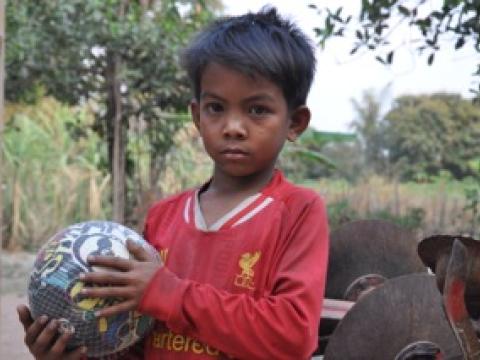One Goal: Nutrition for every child

By: Lindsey Talerico-Hedren, One Goal Asia
“Sport has the power to change the world.” –Nelson Mandela
The crowd grows silent. The kick. The ball is in mid-air. It hits the back of the net. Spectators are out of their seats. Everyone in the stadium is on their feet, roaring, celebrating.
There are more than 4.6 billion people in the diverse region of Asia. They speak more than 1000 languages in 47 countries. They represent vastly different aspects of Asian art, music, cuisine, and literature. But there is one pastime that unifies the most populous region on earth: Football. In 2006, Asia exceeded by more than 20 million the number of people who play football in Europe with more football players than the combined number in the Caribbean and North, Central and South America. Football is central to Asian society and culture.
But something else is, too. There is something else that the many countries and people across Asia share: A startling number of malnourished children, the highest for any region in the world.
Let’s talk numbers
- Every year, undernutrition is responsible for over three million child deaths globally, an underlying cause in 45% of all child deaths under age five. One-quarter of Asia’s 350 million children under-five are underweight and at much greater risk of disease and death than their healthy, well-nourished peers.
- Globally, 165 million children under- five are stunted – too short for their age. 100 million of these children impacted by not consuming the proper nutrients live in Asia.
- At the same time, 16.5 million children under-five in Asia are overweight and obese, this number is expected to rise to 23.1 million by 2025
Let’s talk children
- In Nepal – a country where the health of girls is not a household priority – sisters Sabitha (age 5) and Sita (age 2) are severely malnourished. Sabitha has seldom had the chance to eat healthy and nutritious food in her life. Sita has never eaten anything but rice and milk, she is too weak to stand or walk. At two-years-old she’s lived a life of malnutrition and barely has the strength to crawl, she may not live to her fifth birthday.
- In Cambodia, 40% of children are stunted. Vandin, who is 10-years-old now, is called Tdeur (means dwarf) by his friends. Undernutrition at a young age caused his growth to be stunted, he is the same height as children two years younger. His favourite sport is football but a childhood of undernutrition means he won’t be able to compete equally with his peers on the field.
- In Mongolia, there is a three-year-old girl called Munkhjin. She cannot walk. Her legs are weak from a life of malnourishment causing her bones to become deformed so she can only sit on the floor
Sabitha, Sita, Vandin, and Munkhjin have something in common, too. They are part of Asia’s uneven nutritional playing field, a next generation of children who won’t be able to compete with their peers in life or in football because they lacked the proper nutrients needed at an early age to grow physically and mentally to their potential.
It is fact that a child born today into a poor community in Asia will not have the same opportunities to participate and develop through organised sport as his or her counterpart in Europe or North America. Asian children lack the opportunities to compete with their international counterparts but they also lack the stamina and health. Why? Malnutrition.
Let’s talk action
Nelson Mandela said: “Sport has the power to change the world. It has the power to inspire. It has the power to unite people in a way that little else does. It speaks to youth in a language they understand. Sport can create hope where once there was only despair. It is more powerful than government in breaking down barriers.”
Football is the most watched sport on television in Asia. During the South Africa 2010 FIFA World Cup, Asia’s television audience was the highest, 884.4 million viewers. Football has perhaps the largest and most uniquely positioned audience in all of Asia for addressing its double burden of malnutrition.
There are 1.4 billion football fans in Asia… 1.4 billion people who are grounds for a movement that can tackle the issue of child malnutrition.
ONE GOAL
The ONE GOAL campaign is a partnership initiative of World Vision, Asian Football Confederation, Global Alliance for Improved Nutrition, DSM, and Asian Football Development Project with one goal: Nutrition for every child. With football as the catalyst, ONE GOAL seeks to bring awareness to the issue of child malnutrition in Asia and powerfully inspire and mobilise the football community to take action to increase the number of children in Asia who survive and thrive.
With advocacy, research, and awareness at a community level and the building of new networks that can advocate for improved nutrition at a national and international level, ONE GOAL harnesses the power of football as the vehicle that can popularise the issue of malnutrition in Asia.
The ONE GOAL campaign asks you to be a part of the team that seeks to level the playing field for Asia’s children. By improving nutrition for every child in Asia, we will not only save lives, we’ll create a transformative ‘homeside advantage’ for future generations.
ONE GOAL joins the Global Week of Action with a message that all children should #Survive5, and for all children in Asia to have a sporting chance at life.
The One Goal campaign has a vision of contributing to healthier children, fans and football players across Asia. Join their movement on Facebook, Twitter, Google Plus, and at onegoal.asia.